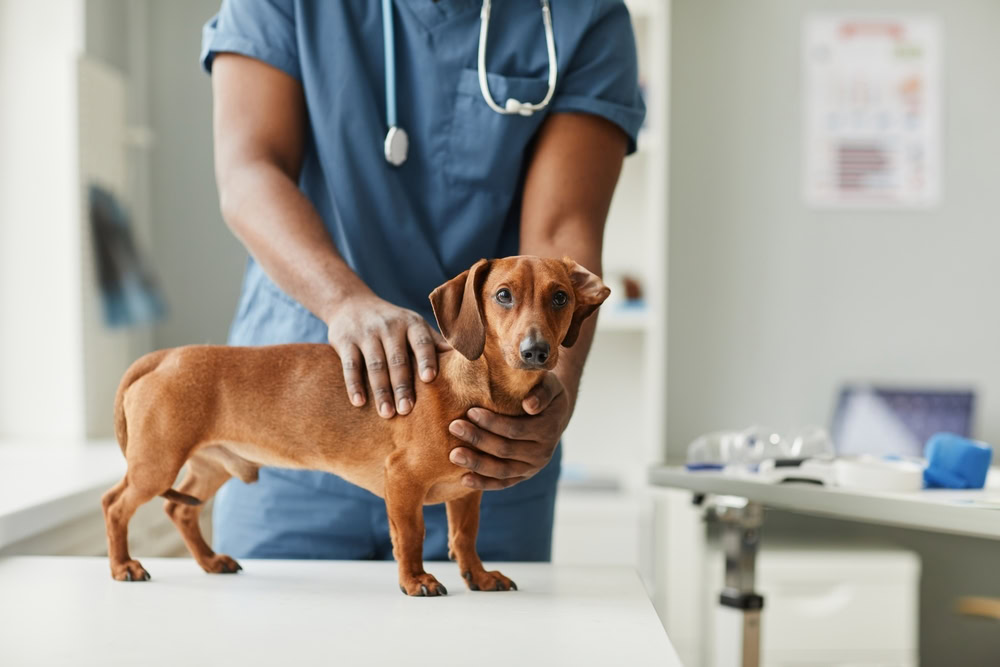
[ad_1]
Intervertebral disc disease, otherwise known as IVDD, is a very common condition seen in dogs of any age. While typically we see this in smaller to medium-sized dogs, it can absolutely affect any breed. Unfortunately, Dachshunds are the most common breed we see with IVDD. Cases can range from mild to severe, with some dogs having multiple episodes in their lifetime. Let’s talk more about what IVDD is, what to look for, what your treatment options are, and a few things you may be able to do for prevention.

What Is IVDD?
IVDD is intervertebral disc disease. This disease is what many people may be aware of in themselves as a bulging or herniated disc. In humans, our spinal cord runs vertically (up and down), with the vertebrae protecting it. In between each vertebra is a soft structure called an intervertebral disc, which helps protect against compression, pressure, and other trauma to the spinal cord. When one or multiple of these discs bulge out, it can put pressure on the associated nerves, vessels, and surrounding structures such as the spinal cord. The worst-case scenario is when the entire disc actually explodes or herniates out of the space, causing significant trauma to the adjacent spinal cord and nerves.
In dogs, due to their anatomy, their vertebrae and spinal cord run horizontally. The concept is the same as humans, only the anatomy is different due to dogs walking on four legs, and humans walking upright on two legs. Each dog has 26 intervertebral discs, with rare exceptions. IVDD is when one or multiple of these discs squish out of their space, causing trauma to the surrounding structures. Some dogs will only have one episode of IVDD their entire life. I’ve also seen dogs who have had surgery up to three times in their lifetime, with a different disc affected each time. Dachshunds are over-represented due to their excessively long body and spine.

What Are the Signs of IVDD in a Dachshund?
Sometimes mild signs are seen for hours to days leading up to a worsening progression. Other times I’ve seen dogs who have been crated all day/night as per their usual routine, only to have owners find them acutely paralyzed. And still other times a tall jump and/or fall may be the catalyst for things to start.
Mild signs will include ataxia, or incoordination, and pain. Your Dachshund may look as if their limbs are not well controlled, almost a “drunken” type walk. You may hear or notice your dog scuffing one or multiple feet as they walk. If the disc is in the neck, your Dachshund may not want to move their head/neck up and down, causing them to be hesitant to eat, drink, or use the stairs. If the disc affects the back legs, you may notice your Dachshund standing hunched over or having weakness, shaking, or pain associated with their back legs.
After incoordination and pain, a worse sign is loss of motor or movement to one or multiple legs. The legs affected depend on where the diseased disc is, and your veterinarian will help determine this based on their exam findings. Your Dachshund may start to drag one or both back legs, or be completely down in their front legs – knuckling over and unable to push themselves up and/or walk. Oftentimes the affected dog will be extremely painful, panting, vocalizing, and not wanting to eat and/or drink. When there is loss of motor, oftentimes your dog is unable to urinate and/or defecate appropriately. Either they cannot express out, or constantly dribble due to the lack of tone.
The worst-case scenario is lack of deep pain, motor, and ability to feel one or multiple limbs. This will require testing by your veterinarian to determine. There can be a progression from mild to severe signs over hours to days, or the severe signs can come on acutely.

What Are the Causes of IVDD in a Dachshund?
To understand why this happens, we must first learn a little bit more about the anatomy. Each intervertebral disc has two main parts – the outside covering called the annulus fibrosus, and the inside portion called the nucleus pulposus. A terrible yet effective analogy is comparing each disc to a jelly-filled donut. The outside annulus fibrosus is by nature much stronger and fibrous. The inside “jelly” portion is gelatinous. When the spine moves and/or absorbs any shock, such as when your dog jumps off the couch, the nucleus pulposus absorbs this and then radiates the pressure equally outwards.
As your dog ages, their vertebrae and the discs age as well, and each disc becomes less elastic and not able to absorb shock and pressure as easily. The discs can become calcified or even absorb and radiate forces unevenly. This is important because as this occurs, every day stressors to the spine can potentially damage these discs more easily as they are unable to do their jobs.
When a pressure is applied to an area of the spine and an aged disc cannot absorb and then distribute the stress evenly, the disc will then bulge or extrude out. When the disc ruptures out the nucleus pulposus, or the jelly-like center, this is considered Type I disc disease or extrusion. This is most common in the Dachshund. When there is extrusion of the outer portion of the disc, the annulus fibrosus, this is called Type II disc disease.
The Dachshund, along with other smaller breed dogs such as the French Bulldog, may start to develop these age changes to their discs as early as 8–24 months of age! Approximately 25% of Dachshunds will develop some type of IVDD in their lifetime with the highest incidence occurring between 3 and 7 years old. This is quite different from other larger breeds who more commonly have issues between 8 and 10 years of age.

Diagnosing IVDD in Your Dachshund
A presumptive diagnosis of IVDD is made by your veterinarian on an exam. Based on your Dachshund’s clinical signs and history of any trauma, your veterinarian will be able to make a fairly good assumption about IVDD. However, the only definitive diagnosis lies in advanced imaging.
In other words, either CT or an MRI, often with contrast, is needed. Radiographs are absolutely not definitive. Your veterinarian may recommend them to look for any signs of arthritis, fractures or narrowed disc spaces. However, X-rays are not sensitive enough to see any extruded disc material and associated damage to the spinal cord. Oftentimes if owners wish to pursue advanced imaging and a surgical consultation, I save them the money spent on radiographs and just send them immediately for advanced imaging with a specialist.
How Do I Care for a Dachshund With IVDD?
The most important thing is to get your Dachshund evaluated immediately when you notice them acting abnormally. The minute you notice them hunching over, scuffing their legs, acting drunk in the back end or unable to move their legs, you need to take them to a veterinarian. Based on your dog’s age and severity of clinical signs, your veterinarian will discuss conservative therapy and surgical options. If you choose surgery, timing is extremely important. In dogs who are unable to feel their legs, surgery should be performed in the first 48 hours in order for the best outcome. This surgery is very specialized and can only be performed by a Board Certified Surgeon or Board Certified Neurologist. Advanced imaging, discussed above, is an absolute must. You should absolutely never pursue surgery if the doctor is not boarded and/or only using X-rays.
Conservative therapy involves aggressive pain medications, some type of anti-inflammatory (typically a steroid or NSAID) and strict rest. Absolutely no activity off leash can be done for up to 2 months time, and sometimes longer. This can be difficult for many families to adhere to. However, it’s a great option as surgery is often out of people’s financial limits (it can cost upwards of $10,000 depending on where you live). Depending on your Dachshund’s signs, you may need to express their bladder or do some exercises with them while they heal. All of these things need to be managed by a veterinarian, as some movement can be harmful.
While there are benefits to some alternative therapies, chiropractic work should never, ever be completed in a Dachshund, or any breed, suffering from IVDD. This can cause more trauma to the spinal cord and affect other discs. Acupuncture and underwater treadmill therapy may be great options depending on your dog’s specific case.


Frequently Asked Questions (FAQ)
Can I prevent IVDD in my dachshund?
Nothing is completely preventable. However, one of the most important things you can do is keep your Dachshund lean and in shape. Obesity only adds excessive pressure to the vertebrae, discs, and spinal cord. Also train your pup early to use ramps and stairs and avoid allowing them to jump on and off high surfaces such as furniture and decks. It only takes one high jump and/or fall to cause injury to the back.
Should I Just Wait For Them to “Walk it Off”?
No! This is an extremely painful condition. Waiting may cause additional swelling and/or hemorrhage to occur at the area of the injury. You would not be able to see this with your naked eye. Therefore the sooner you get your Dachshund evaluated and started on medications, the sooner they will be more comfortable, and hopefully their condition will not worsen.
What Is My Dachshund’s Prognosis?
These numbers are constantly being updated and changed as new study results emerge. In general, dogs who do not have any deep pain at the time of diagnosis and are treated conservatively only have a 5–10% recovery rate, with a 50% recovery rate if surgery is pursued within 48 hours. In dogs who have intact pain, the recovery rate with surgery can be upwards of 80–95%. The rate of recovery varies greatly in dogs who have intact deep pain with conservative treatment but in general is greater than 50% without surgery.


Conclusion
IVDD, or intervertebral disc disease, is a common occurrence in small to medium sized dogs of any age. We can see this occur in any breed of dog, but the Dachshund is far and away the most common breed affected. Dachshunds most commonly suffer from Type I disc disease and their signs can vary from mild to severe. Some Dachshunds will have only one episode of IVDD in their life, while others may have a lifelong battle.
Your Dachshund should be evaluated by a veterinarian as soon as you notice any abnormal signs. The quicker your Dachshund is either started on medications or taken to surgery, the better their prognosis. Your veterinarian will discuss all treatment options with you based on your dog’s specific signs. Conservative therapy and surgery should only ever be managed by trained veterinarians and veterinary staff for the best outcome.
Featured Image Credit: SeventyFour, Shutterstock
[ad_2]
Source link


